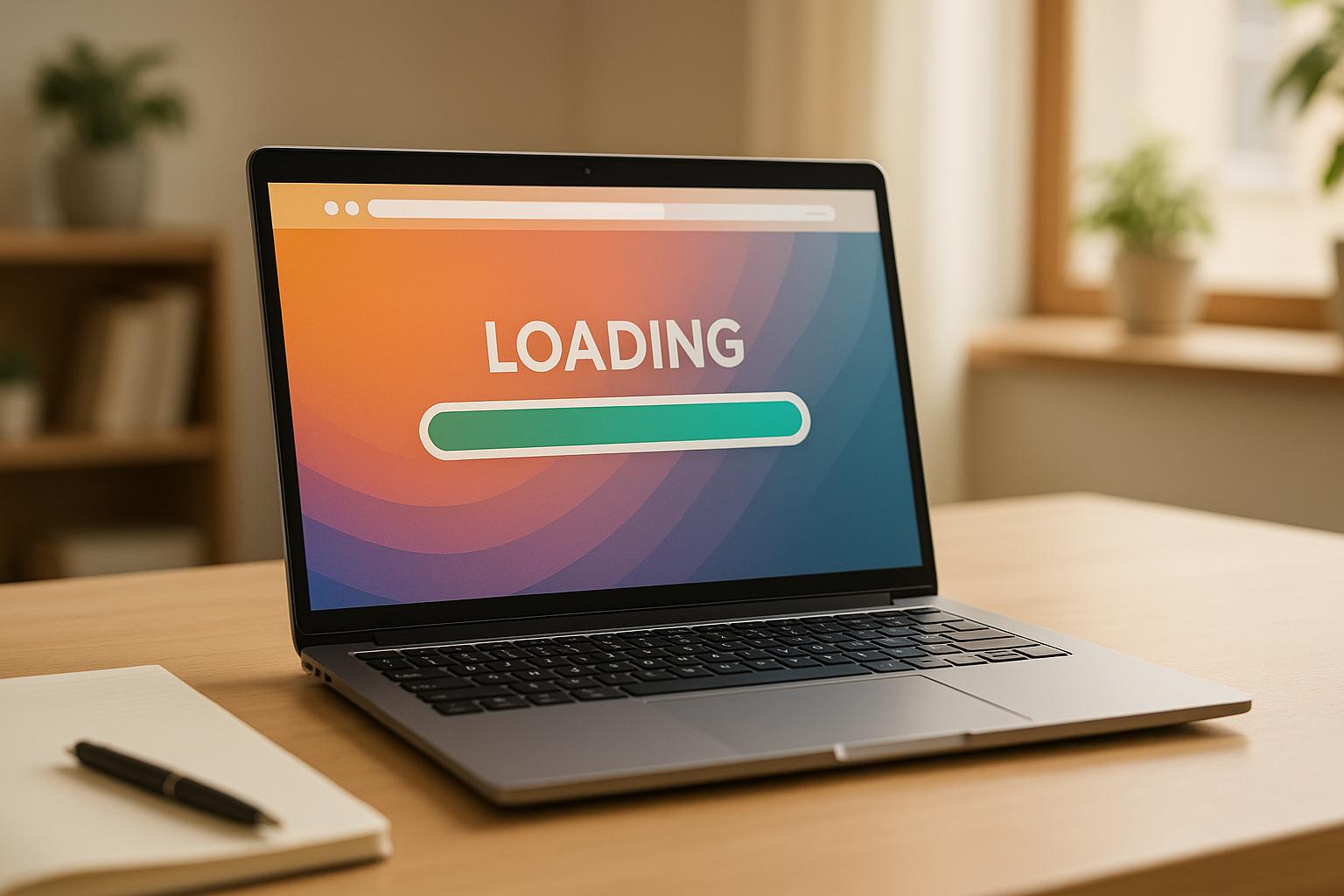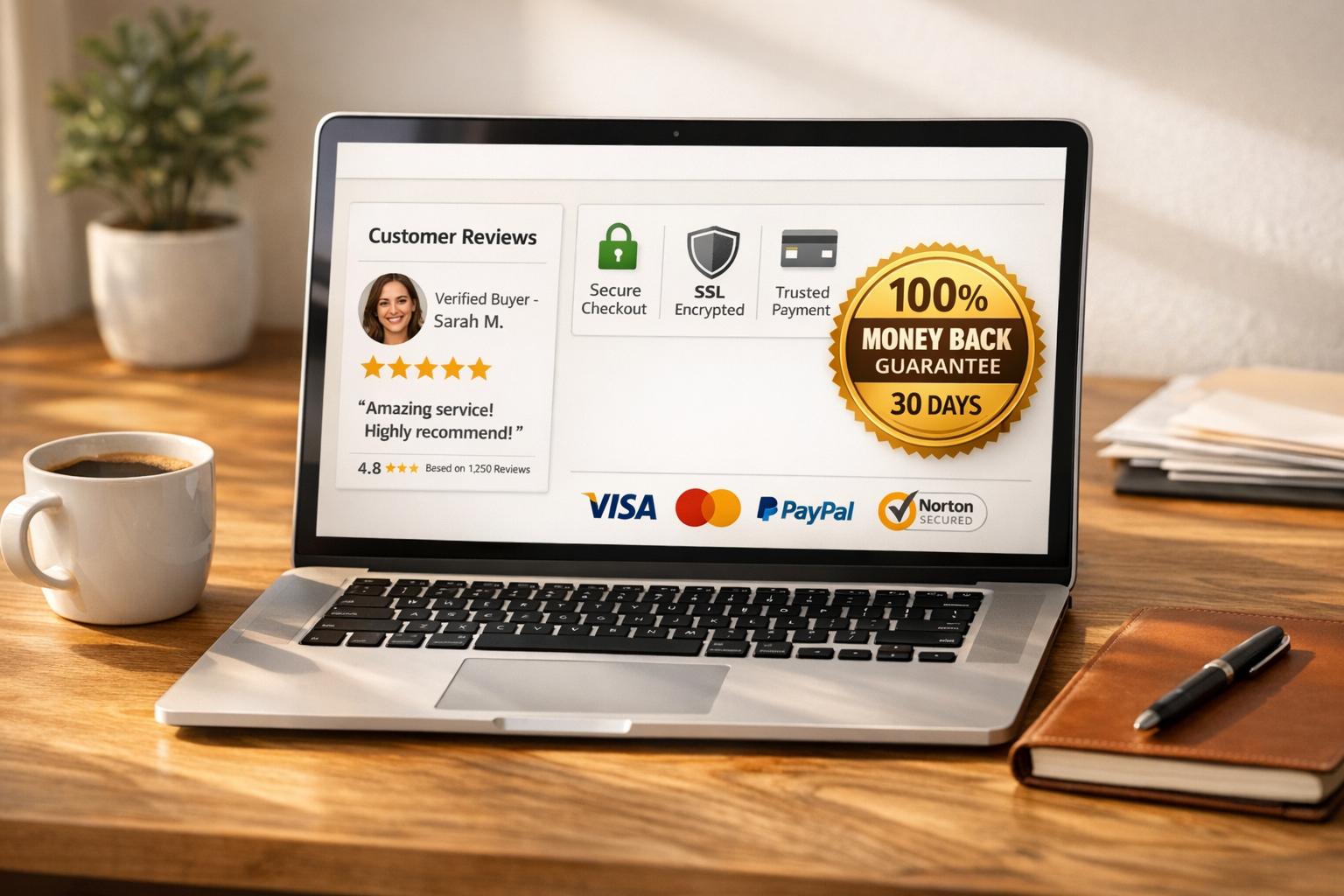

Page Load Time vs. Conversion Rates

Page Load Time vs. Conversion Rates
 01-07-2025 (Last modified: 05-12-2025)
01-07-2025 (Last modified: 05-12-2025)
A slow website can cost you customers and revenue. Here’s the core takeaway: Pages that take over 3 seconds to load lose 40% of users, and for every extra second, conversion rates drop by around 7%. Faster sites keep visitors engaged, drive more actions like purchases or sign-ups, and boost revenue.
Key Insights:
- 1-second delay = 7% drop in conversions. For an e-commerce site earning $100,000 daily, that’s $2.5M lost annually.
- Mobile users are less forgiving. A poor mobile experience can cut conversions by 22%.
- Optimal load time = 2 seconds or less. Pages loading in 2.4 seconds see a 1.9% conversion rate, while pages over 5 seconds drop to 0.6%.
- Major brands like Walmart and Amazon have seen revenue jump with even small speed improvements.
Why It Matters:
Users expect fast, seamless browsing. Slow load times frustrate them, increase bounce rates, and hurt your brand’s credibility. Faster sites not only improve user satisfaction but also directly impact your bottom line.
How To Improve:
- Compress images and reduce file sizes.
- Use a Content Delivery Network (CDN) for faster global access.
- Minify code (CSS, JavaScript) and limit HTTP requests.
- Optimize for mobile – mobile traffic often makes up over half of visits.
By prioritizing speed, you’ll not only meet user expectations but also see a measurable lift in conversions and revenue.
Does Page Speed Matter? | Importance of Website Loading Time | WP Amaze
How Page Load Time Affects Conversion Rates
Speed isn’t just a technical detail – it’s a business-critical factor. When your website takes too long to load, it directly impacts your conversion rates. The relationship is simple: the slower the load time, the fewer conversions you get. And that translates to lost revenue, missed opportunities, and a hit to your business performance.
How Small Delays Impact Conversions
Even a tiny delay can have a big impact. A one-second delay in page load time can result in a 7% drop in conversions. To put that into perspective, if your site typically converts at 3%, a one-second delay could lower that to 2.79%, costing you thousands of potential actions.
For e-commerce sites pulling in $100,000 daily, that one-second lag could mean losing $2.5 million in annual revenue. It’s no wonder major online retailers invest so much in improving speed.
Mobile users are even more sensitive to delays. Poor mobile speed can slash conversions by up to 22%. On the flip side, a 0.1-second improvement in mobile site speed can boost conversions by 8.4%, while saving a full second typically results in a 3% increase in mobile conversions.
The numbers don’t lie. Real-world examples drive home the point:
- Walmart saw a 2% increase in conversions with a one-second speed improvement.
- COOK boosted conversions by 7% after shaving 0.85 seconds off their load time.
- At Mobify, every 100ms improvement added 1.11% to their conversion rate.
Different industries feel the impact differently. For instance, a 0.1-second speed improvement can lead to:
- A 10.1% increase in conversions for travel sites.
- An 8.4% rise in conversions and a 9.2% bump in average order value for e-commerce platforms.
- Even luxury brands saw a 3.6% lift in conversions, with a 40.1% jump in users adding items to their carts.
Key Page Load Time Thresholds
Knowing when delays start to hurt conversions is key to prioritizing your optimization efforts. Certain load time thresholds are critical for maintaining user engagement and conversion performance.
The 2-second mark is what most users expect. Nearly half of all users (47%) expect pages to load in 2 seconds or less. Pages meeting this benchmark typically see the best conversion rates, with a solid 1.9% conversion rate for pages loading in 2.4 seconds.
But once load times creep past 3 seconds, things take a sharp turn for the worse. For example:
- At 3.3 seconds, conversion rates drop to 1.5%, and bounce rates jump by 32%.
- At 4.2 seconds, conversion rates fall below 1%, with 63% of visitors abandoning the site.
- Beyond 5 seconds, conversion rates collapse to just 0.6%, and bounce rates increase by a staggering 90%.
Here’s a quick breakdown:
| Load Time | Conversion Rate | User Behavior Impact |
|---|---|---|
| 2.4 seconds | 1.9% | Optimal performance zone |
| 3.3 seconds | 1.5% | 32% increase in bounce rate |
| 4.2 seconds | <1% | 63% of visitors abandon site |
| 5.7+ seconds | 0.6% | 90% increase in bounce rate |
These numbers make it clear: speed isn’t just a "nice-to-have" – it’s a must. Companies that prioritize performance see real results. Take Rakuten 24, for example. By focusing on Core Web Vitals, they achieved a 33.13% increase in conversion rates. redBus optimized their Interaction to Next Paint (INP) metric and saw a 7% increase in sales. OfficeRnD, after a full-scale web performance overhaul, boosted their conversion rates by 10%.
Bottom line? Every second matters. Staying under 3 seconds keeps you in the game, but aiming for that 2-second sweet spot can give you a real edge. These stats prove that optimizing load time is one of the smartest moves you can make to drive conversions.
User Psychology: Why Speed Matters
When it comes to slow websites, the problem goes deeper than just numbers – it’s about understanding how people think and react. Over the past few years, users’ expectations have evolved dramatically. Their patience has dwindled, attention spans have shortened, and waiting for a website to load feels like an unbearable inconvenience.
Users Expect Instant Results
We live in a world where instant gratification is the norm, and websites are no exception. Nearly half (47%) of consumers expect a website to load in 2 seconds or less. This isn’t a casual preference – it’s a firm expectation that shapes how users navigate the internet.
Failing to meet this expectation has real consequences. Users don’t just get frustrated – they leave. Mobile users are even less forgiving: 53% of them abandon a page if it takes longer than 3 seconds to load.
"As consumers are becoming more time-poor and attention spans are decreasing, slow-loading pages can deter purchases." – Daniel Cheung, SEO and Marketing Professional
The psychology behind this behavior lies in how we perceive waiting. Slow load times don’t just feel inconvenient – they seem even slower than they actually are. Studies show that users perceive load times to be about 15% longer than they are. Even worse, they later remember those load times as being up to 35% slower.
This creates a double hit: a 3-second load time feels like 3.45 seconds in the moment and is remembered as over 4 seconds later. That perception gap makes optimizing for speed even more critical.
And it doesn’t stop there. Slow websites also increase cognitive load. Research reveals that users have to focus 50% more when browsing on slower connections. This added mental effort leads to frustration, making users far more likely to give up and leave.
How Slow Loading Reduces User Engagement
Speed isn’t just about keeping users on your site – it shapes how they interact with it. Slow loading times directly reduce engagement and conversion rates by triggering negative behaviors.
The drop-off is steep. A Google study found that 92% of users completed their goals on sites they perceived as fast, compared to just 73% on slower sites. That’s a 19-point difference in task completion, all because of speed perception.
The damage doesn’t end with one bad experience. 95% of users are likely to return to fast-loading sites, but only 62% would revisit slower ones. Once users encounter a slow site, they’re hesitant to give it another chance.
"Not only are users expecting to see results quickly, and become disappointed when they don’t, but page speed also immediately affects their professional opinion of you." – Diona Kidd, Managing Partner at Knowmad Digital Marketing
Major brands have seen this play out firsthand. For example, the BBC discovered that every additional second of load time led to a 10% increase in user abandonment. On the flip side, the Financial Times saw a 5% boost in engagement by shaving just a few seconds off their load times.
Page speed also has a direct impact on purchasing behavior. 70% of consumers say page speed influences their buying decisions, and 62% of mobile users are less likely to make a purchase after a negative experience. This creates a downward spiral where slow websites not only lose immediate sales but also harm long-term revenue potential.
Beyond individual sessions, slow pages damage your brand’s reputation. 75% of users who experience slow, freezing, or crashing sites won’t buy from that site again. Worse still, 88% of online consumers are less likely to return after a poor experience. Even if your products or prices are great, a sluggish website can make users question your reliability and professionalism.
The takeaway? Speed isn’t just about technical performance – it’s about creating a seamless experience that builds trust, encourages engagement, and keeps users coming back. A fast website isn’t just a convenience; it’s a necessity for building lasting relationships with your audience.
sbb-itb-6e49fcd
Performance Benchmarks for Page Speed and Conversion Rates
When it comes to page speed, the numbers speak for themselves. Even a slight delay can drastically impact user behavior and, ultimately, conversions. By understanding the benchmarks tied to page load times, businesses can set achievable goals and track their progress effectively. U.S. data highlights clear trends that show how speed influences performance across industries.
The connection between load time and conversions is striking. For example, a 3% conversion rate can drop significantly with just a one-second delay. Real-world examples from major companies drive this point home. Amazon, for instance, reported a 1% increase in revenue for every 100ms improvement in page load time. Similarly, Mozilla boosted Firefox downloads by 60 million annually by reducing page load time by 2.2 seconds. These examples underscore how crucial speed is for maximizing performance.
The ideal range for page load times is between 0 and 2 seconds, where conversion rates are at their highest. To better understand the impact of load times on user behavior and conversions, the table below outlines key benchmarks:
Conversion Rates by Load Time
| Load Time (seconds) | Conversion Rate Impact | User Abandonment | Key Insight |
|---|---|---|---|
| 1 | Up to 3x higher for e-commerce sites | Minimal abandonment | Peak performance zone |
| 2 | Highest overall conversion rates | Low abandonment | Optimal target for most sites |
| 3 | 20% decrease compared to a 1-second load | About 40% abandon the site; 53% of mobile users leave | Critical drop-off point |
| 5 | Approximately 4.42% drop per additional second | High abandonment rates | Significant performance degradation |
| 10+ | Severe conversion loss | Extremely high abandonment | Business-critical threshold |
At the three-second mark, user abandonment becomes a serious issue. Roughly 40% of visitors leave the site, and this figure jumps to 53% for mobile users. This not only reduces immediate conversions but also limits future opportunities to re-engage those visitors.
For e-commerce sites, the stakes are even higher. Pages that load in just one second can see conversion rates triple compared to slower-loading pages. B2C websites, in particular, face steep penalties for slow speeds, with conversion rates dropping by an average of 2.11% for every second beyond the 2-second mark. While B2B sites are also impacted, their longer sales cycles may slightly cushion the blow of slower load times.
Mobile users are especially impatient, often making up more than half of total traffic. This makes optimizing mobile speed critical for maintaining strong conversion rates across the board.
These benchmarks highlight the importance of speed as a strategic tool for improving conversions. Businesses aiming to optimize performance can use tools like PageTest.AI to measure current speeds and experiment with improvements. Running A/B tests and tracking how speed adjustments affect key metrics can help identify the changes that resonate most with your audience. By prioritizing faster load times, you can unlock better performance and more conversions.
How to Improve Page Load Time for Better Conversions
Once you’ve set performance benchmarks, it’s time to take actionable steps to improve load times and, in turn, boost conversions. With the right strategies, you can see noticeable improvements in just a few weeks. Below are some effective techniques to help your website load faster and perform better.
Proven Methods to Improve Page Load Time
Optimize images: Compress large image files, convert them to WebP format, and ensure they’re resized to match display dimensions. Since images often make up a significant portion of a page’s weight, these adjustments can drastically reduce load times.
Reduce HTTP requests: Limit the number of HTTP requests by minifying CSS and JavaScript files, using CSS sprites, and enabling browser caching. Fewer requests mean faster load times.
Streamline your code: Clean up your HTML, CSS, and JavaScript to make them leaner and quicker to execute. Many website platforms provide plugins or built-in tools to handle these optimizations automatically.
Use a Content Delivery Network (CDN): CDNs distribute your website’s content across servers worldwide, ensuring visitors receive data from the server closest to their location. This significantly decreases load times, especially for global audiences.
Improve server response times: Upgrading your hosting plan, enabling page caching, and hosting large files like videos on dedicated platforms can make a big difference. These steps ensure your server delivers content more efficiently.
Prioritize mobile optimization: Mobile pages often take much longer to load than desktop versions – on average, 70.9% longer. For example, Zitmaxx Wonen saw a 50.2% increase in mobile conversions after cutting load times to under 4 seconds.
Using AI for Testing and Optimization
Beyond technical fixes, AI tools can refine your optimization efforts by testing and improving key website elements. These tools identify faster, higher-performing versions of elements like headlines, calls-to-action, and button text.
Platforms like PageTest.AI combine speed optimization with conversion testing. They use AI to create and test different variations of critical page elements, addressing both technical performance and user engagement. This dual focus makes AI tools a powerful addition to your optimization strategy.
Tracking performance metrics is essential. Go beyond traditional speed measurements and monitor user engagement metrics such as clicks, time on page, and scroll depth. For example, Vodafone improved its Largest Contentful Paint (LCP) by 31% through A/B testing, which led to an 8% increase in sales.
AI-powered tools work seamlessly with platforms like WordPress, Wix, Shopify, and custom-built websites. They analyze your site’s performance, provide improvement suggestions, and run automated tests – all without requiring advanced coding skills. This makes it easier to find the fastest and most effective content variations.
Real-world examples highlight the impact of these strategies. Agrofy improved their Core Web Vitals, such as First Contentful Paint (FCP) and Largest Contentful Paint (LCP), reducing abandonment rates from 3.8% to 0.9%. Similarly, Pfizer cut load times by 38%, which lowered bounce rates by 20%.
The secret to success lies in viewing speed and conversions as interconnected goals. Regular testing and monitoring ensure your website keeps evolving to meet user expectations. By combining technical improvements with AI-driven testing, you can achieve faster load times and higher conversion rates in a sustainable way.
Conclusion: The Connection Between Speed and Success
Page speed isn’t just a technical detail – it’s a critical part of your business strategy that directly affects your revenue. Even small improvements in load time can lead to noticeable gains, as past benchmarks have shown. This makes ongoing efforts to improve speed not just worthwhile but necessary.
The numbers speak for themselves: faster websites meet user expectations, drive better conversions, and build long-term customer loyalty. They also encourage repeat visits and generate positive word-of-mouth, fueling sustainable growth. Take Mozilla, for example. By shaving 2.2 seconds off their page load time, they boosted annual downloads by a staggering 60 million.
To stay ahead, businesses must embrace tools and strategies that support continuous improvement. User expectations are always evolving, competitors are stepping up their game, and even minor website changes can impact performance. Regular testing, monitoring, and tweaking are essential to keep your site running smoothly and efficiently.
Fortunately, modern solutions make this process easier. Tools like PageTest.AI offer a powerful combination of speed optimization and AI-driven testing. This approach not only enhances technical performance but also ensures your content is working hard to convert visitors into loyal customers. It’s a comprehensive way to address the full user experience – from fast load times to effective engagement.
In today’s fast-paced digital world, successful businesses recognize that speed and conversions go hand in hand. By prioritizing load times and leveraging advanced tools for ongoing optimization, you can deliver a website that not only meets but exceeds user expectations. Speed isn’t just a competitive edge – it’s the foundation for achieving online success.
FAQs
How does faster page load time affect mobile user engagement and conversions?
Faster page load times make a big difference in keeping mobile users engaged and boosting conversion rates. When pages load quickly, the experience feels smoother and more enjoyable – something especially important for mobile users who are often on the move. Even a one-second delay can increase bounce rates and cost you potential customers.
Studies highlight the impact of even small changes. For instance, shaving off just 0.1 seconds from load times can increase conversion rates by more than 1%. A faster site keeps users interested, minimizes frustration, and encourages actions like purchases or sign-ups. Focusing on mobile performance isn’t just a nice-to-have – it’s a must if you want to keep users coming back and achieve your goals.
How can I improve page load times to boost conversion rates?
Improving how quickly your website loads is a game-changer when it comes to creating a better user experience and boosting conversions. Here are some practical ways to make it happen:
- Enable lazy loading: This ensures images and videos only load when they’re about to appear on the user’s screen, cutting down on initial loading time.
- Streamline JavaScript and CSS files: Remove any unnecessary code and compress these assets to make them smaller and faster to load.
- Cut down on HTTP requests: Combine files where possible and use compression to reduce the number of requests your site makes.
- Take advantage of browser caching: Store static resources like images, stylesheets, and scripts locally for users who revisit your site.
- Use a Content Delivery Network (CDN): A CDN helps deliver your content from servers located closer to your users, reducing latency.
- Optimize third-party scripts: Limit how many third-party scripts you use or load them asynchronously so they don’t slow down the main content.
These steps can make your website noticeably faster, keeping visitors engaged and more likely to convert.
Why is website speed so important for improving conversions and online success?
Website speed plays a huge role in online success, shaping user experience, engagement, and conversion rates. A site that loads quickly keeps visitors interested, lowers bounce rates, and encourages them to stick around longer – often leading to more sales and loyal customers.
Studies reveal that if a website takes more than 3 seconds to load, many users will simply leave. Beyond losing potential conversions, a slow site can also hurt your search engine rankings, making it harder for new customers to discover you. By focusing on speed, you create a smoother experience that builds trust and keeps your audience coming back.
Related Blog Posts
say hello to easy Content Testing
try PageTest.AI tool for free
Start making the most of your websites traffic and optimize your content and CTAs.
Related Posts

 06-01-2026
06-01-2026
 Ian Naylor
Ian Naylor
Ultimate Guide to Trust Signals for CRO
How trust signals — reviews, security badges, guarantees, and design — reduce hesitation and boost conversions with strategic placement and testing.

 05-01-2026
05-01-2026
 Ian Naylor
Ian Naylor
Top Tools for Hyperlocal Content Personalization
Compare top AI tools for hyperlocal content: A/B testing, local SEO, real-time personalization, and social tools to improve local engagement and ROI.

 03-01-2026
03-01-2026
 Ian Naylor
Ian Naylor
AI Tools for Multilingual Keyword Research
How AI tools speed up multilingual keyword research with translation, intent analysis, and regional insights—while stressing the need for human validation.
